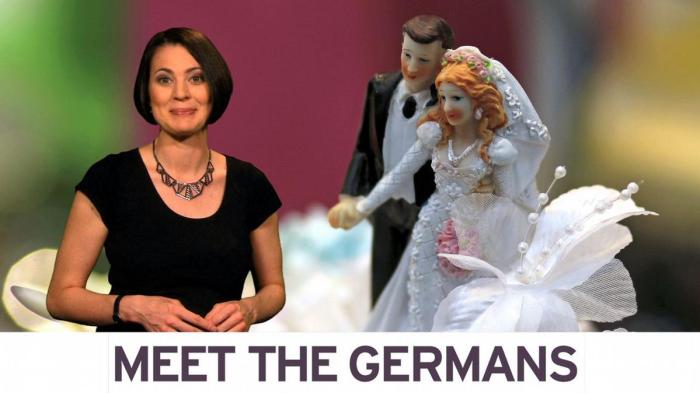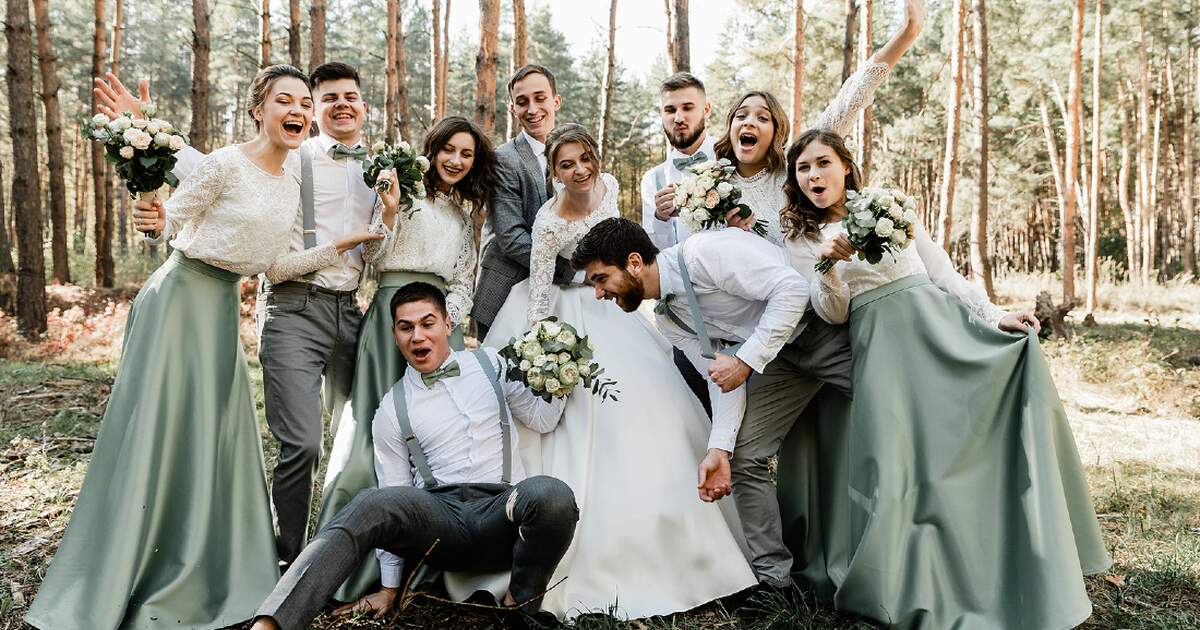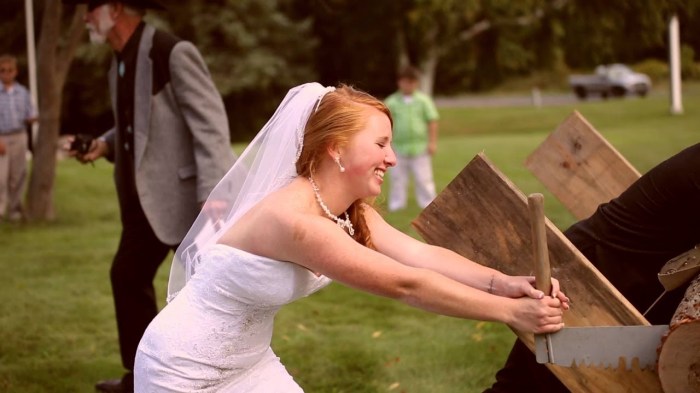Historical Context of German Wedding Dress Traditions
German wedding dress traditions – German wedding attire has undergone a fascinating evolution throughout history, reflecting changing social structures, religious beliefs, and regional identities. From the simple linen garments of the peasantry to the elaborate gowns of the aristocracy, the details of a bride’s dress often conveyed her social standing and regional origins. Religious practices, particularly those of the Catholic and Protestant churches, significantly influenced wedding customs, including the attire.
Evolution of German Wedding Attire

Source: dw.com
In earlier periods, particularly the Middle Ages, German wedding dresses were relatively simple, often consisting of long, dark-colored gowns made of readily available materials like linen or wool. Elaborate embellishments were reserved for the wealthy. The Reformation in the 16th century introduced some shifts, with Protestant regions often favouring simpler styles compared to the more ornate Catholic traditions. The 18th and 19th centuries saw the rise of more elaborate styles, influenced by court fashion and the romantic ideals of the era.
White, symbolizing purity, gradually became the dominant colour, though this wasn’t universally adopted until later.
Influence of Social Class and Regional Variations
Social class played a crucial role in determining the style and materials of German wedding dresses. Wealthier families could afford finer fabrics like silk and velvet, intricate embroidery, and luxurious accessories. Peasant brides, on the other hand, typically wore simpler garments reflecting their economic circumstances. Regional variations were also pronounced, with distinct styles emerging in different parts of Germany.
German wedding dress traditions often emphasize classic elegance, but modern brides are embracing diverse styles. A refreshing departure from tradition could involve a beautiful flower print wedding dress , which adds a whimsical touch while still maintaining a sense of occasion. This reflects a broader trend towards personalized choices within the context of established cultural norms surrounding German weddings.
Bavarian dresses, for instance, often featured vibrant colours and intricate embroidery, while those from northern regions might have been more understated.
Religious Influence on Wedding Dress Customs, German wedding dress traditions
Religious beliefs and practices significantly influenced German wedding dress customs. Catholic traditions often involved more elaborate ceremonies and attire, reflecting the church’s emphasis on ritual and symbolism. Protestant weddings, in contrast, tended to be simpler, emphasizing piety and community. The choice of fabrics, colours, and embellishments could all carry religious significance, varying depending on the specific region and denomination.
Examples of Historical Imagery

Source: iamexpat.de
Paintings and engravings from different historical periods provide valuable insights into the evolution of German wedding attire. For example, portraits from the 18th century often depict aristocratic brides in opulent gowns with elaborate lace and embroidery, while depictions of peasant weddings show simpler dresses made of darker fabrics. These visual representations highlight the diversity of styles and the social and regional contexts in which they existed.
One could imagine a painting from the late 19th century showing a bride in a long white gown with a lace veil, representing the growing adoption of the white wedding dress as a symbol of purity and innocence.
Regional Variations in German Wedding Dresses
Germany’s diverse regions boast unique wedding dress traditions, each with its own distinctive styles, fabrics, embellishments, and symbolic meanings. These variations reflect the rich cultural tapestry of the country and the historical influences on each region.
Regional Dress Comparison
The styles of wedding dresses varied significantly across different regions of Germany. These differences often stemmed from readily available materials, local craftsmanship traditions, and regional cultural beliefs. For example, the richly embroidered dresses of Bavaria contrasted sharply with the simpler, more restrained styles found in northern Germany. These regional differences extended to accessories like headpieces and jewelry, further highlighting the diversity of German wedding traditions.
| Region | Dominant Fabric | Typical Embellishments | Symbolic Meaning |
|---|---|---|---|
| Bavaria | Linen, Silk | Intricate embroidery, lace, ribbons | Prosperity, fertility, regional identity |
| Prussia | Wool, Linen | Simple embroidery, dark colours | Modesty, practicality, family heritage |
| Swabia | Linen, Cotton | Floral embroidery, lace collars | Purity, love, connection to nature |
| Saxony | Silk, Velvet (for wealthier families) | Lace, ribbons, pearls | Elegance, social status, family wealth |
Symbolic Elements in Traditional German Wedding Attire
Many elements of traditional German wedding attire carry symbolic meanings, reflecting cultural beliefs and values passed down through generations. These symbols often relate to concepts such as purity, fertility, prosperity, and family unity.
Symbolism of Colors, Veils, and Accessories

Source: businessweddings.com
The color white, while not always traditional, eventually became associated with purity and innocence. Other colours, such as red or blue, held different meanings depending on the region and the specific garment. Veils were often used to symbolize modesty and protection, while specific headpieces could indicate marital status or social standing. Embroidery patterns, frequently featuring floral motifs, represented fertility and the cycle of life.
- White: Purity, innocence.
- Red: Love, passion, fertility.
- Blue: Fidelity, loyalty.
- Veil: Modesty, protection, transition to married life.
- Floral Embroidery: Fertility, abundance, new beginnings.
Modern Interpretations of Traditional German Wedding Dresses
Contemporary designers are increasingly incorporating elements of traditional German wedding attire into modern designs, creating unique and stylish gowns that reflect cultural heritage. This blending of old and new showcases the enduring appeal of traditional aesthetics while adapting them to contemporary tastes.
Modern Designs with Traditional Elements
Modern German wedding dresses often incorporate traditional elements such as intricate embroidery, regional-specific fabrics, or symbolic colours. A designer might use traditional Bavarian embroidery patterns on a sleek, modern silhouette, or incorporate a traditional Saxon lace collar on a minimalist gown. These subtle nods to tradition offer a unique and personal touch.
Comparison of Traditional and Modern Aesthetics
While traditional German wedding dresses often featured darker colours and more elaborate embellishments, modern interpretations frequently favour a simpler aesthetic, using clean lines and elegant silhouettes. However, the incorporation of traditional fabrics, embroidery, or colours provides a connection to the past, creating a unique blend of old and new. The overall effect is a wedding dress that is both contemporary and culturally resonant.
Modern Dress Design
A modern wedding dress incorporating traditional German elements could feature a sleek, A-line silhouette in ivory silk. Intricate Bavarian-style embroidery, featuring floral motifs, could adorn the bodice, while a delicate blue ribbon could be woven into the waistband, representing fidelity. Finally, a simple, yet elegant, veil made of delicate lace could complete the look, subtly referencing traditional German bridal attire.
This design would seamlessly blend modern aesthetics with traditional symbolic elements.
The Role of Family and Tradition in the Modern German Wedding: German Wedding Dress Traditions
Despite the evolving trends in wedding fashion, family traditions continue to play a significant role in modern German weddings, particularly in the selection and preparation of the wedding attire. Family heirlooms and customs are often incorporated, creating a meaningful connection between generations.
Family Involvement in Wedding Attire
Family members often participate in the selection and preparation of the wedding attire. Grandmothers or aunts might share family heirlooms, such as a lace veil or a piece of antique jewelry, to be incorporated into the bride’s outfit. The bride might also choose to incorporate elements from her family’s regional traditions, ensuring a personal and meaningful connection to her heritage.
This collaborative process strengthens family bonds and creates lasting memories.
Significance of Family Heirlooms
Family heirlooms often hold sentimental value and symbolic significance, representing the continuity of family traditions and the passing down of cultural heritage. A grandmother’s wedding dress, for example, could be adapted into a modern design, or a piece of antique jewelry could be worn as a symbol of family unity. These heirlooms add a unique and personal touch to the wedding, making it a truly special occasion.
Narrative Example
Imagine a modern German bride choosing to incorporate her grandmother’s antique lace veil into her contemporary wedding dress. The veil, a family heirloom passed down through generations, represents the enduring love and family unity central to German wedding traditions. This simple act of incorporating a family heirloom creates a meaningful connection between generations and imbues the wedding with a deep sense of history and family heritage.
The bride’s choice reflects a desire to honor her family’s traditions while embracing modern aesthetics, showcasing the harmonious blend of old and new in modern German weddings.
Popular Questions
What is the significance of the color white in a German wedding dress?
While not universally traditional in historical German weddings, white has gained prominence in recent times, largely mirroring Western wedding customs symbolizing purity and new beginnings.
Are there any specific flowers traditionally associated with German weddings?
Specific flowers vary regionally, but cornflowers, edelweiss (in mountainous regions), and various wildflowers are often incorporated, representing local flora and symbolic meanings related to purity, longevity, or good fortune.
What role do family members play in choosing the wedding dress?
Family input is significant. Mothers, grandmothers, or other female relatives often play a crucial role in selecting and even making or altering the dress, passing down traditions and family heirlooms.
Are there any traditional German wedding dress accessories that are particularly significant?
Elaborate headpieces, veils, and specific types of jewelry (often family heirlooms) hold particular significance, carrying symbolic meanings related to protection, good luck, or fertility.
